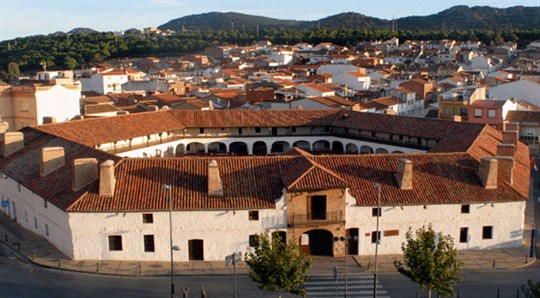Features and functions of the bullring

Speaking of Spain, nothing is more characteristic than elements that mark the urban landscape, topoi that are repeated from town to town: the iglesia, the plaza mayor, the plaza de toros. In particular, here we will focus on the genesis and development of the first places that were witnesses of modern bullfighting, without going into the ensuing ethical debate which is strongly felt in the Peninsula. For a historian such spaces do not cease to be one of the most important examples of sites built (or adapted) to host public spectacles reborn in the seventeenth century.
Beyond any doubt the spectacle of bullfighting is a legacy derived from Roman ancestral Mediterranean culture, but contrary to what might be believed, in the Iberian Peninsula it was not the regions overlooking the Mediterranean which passed on and kept that tradition alive but the northern-central ones. It was, in fact, Christian lands which continued to enjoy the spectacle of bullfighting, which was absent from the Muslim culture of the south and east. Bullfights, therefore, have marked the entire history of these lands, and as the Reconquista advanced towards the southern regions, the Christian armies brought with them their culture and traditions.
Throughout the Middle Ages and the early part of the Early Modern period such “playful spectacles” were not encoded by specific rules, probably for this reason there are no places which were specifically destined to this purpose, at least until the sixteenth and seventeenth centuries. It is precisely in the Baroque period that the standardization of the bullfight began. With the progressive standardization there also came to be specific locations in urban space dedicated to bullfighting, but until the mid-nineteenth century we still find a strong variety of spaces which were deemed suitable for such spectacles. The most common are the plazas provisionales, the plazas mayores and the plazas de toros (bullrings) properly speaking. Little can be said about the provisional squares. They were (and, to date, still are) made of wood, assembled and disassembled for feast days. Nothing remains of the oldest ones if not documents which tell us about the places where they were set up, and for what celebrations. More could be said about the plazas mayores, which date back to the origin and spread of the Christian kingdoms. Direct descendants of the Roman Forum, they were the vital centre of commerce and institutions. In fact, as in other parts of the European continent, the plazas mayores performed the functions of the market and meeting place for citizens, and often there were the two Medieval and Early Modern powers present: the Church and the Ayuntamiento (or noble palace), i.e. the power of the Church and the political and civil power. Covarrubias writes in 1611 that this space was: “… un lugar público ancho y espacioso dentro del poblado, donde se venden los mantenimientos y se tiene el trato común de los vecinos y comarcanos, y donde se celebran ferias, mercados y fiestas publicas.” (S. Orozco Covarrubias, Tesoro de la lengua castellana o española, Luis Sánchez, Madrid 1611).
From the sixteenth century, from Philip II onwards, the creation of these spaces in all cities, both ancient and the new, began to considered and gradually their features began to be standardized. The model included a square or rectangular architectural plan (we will see later that there are exceptions), with buildings with balconies that closed on all sides. As the nerve center of city life the squares were also the protagonists of the various festivities, mostly of a religious nature. In these feasts bullfights were often depicted and not only bullfights but also encierros. The encierro (literally translated, an enclosure) began as a preliminary to the bullfight itself, i.e. the transfer of the bulls to the appointed place for the bullfight. Over time it became a spectacle unto itself when the citizens, in a test of courage, began to run in front or in the middle of the animals. The most famous example is what is still celebrated in honor of San Fermín in Pamplona.
